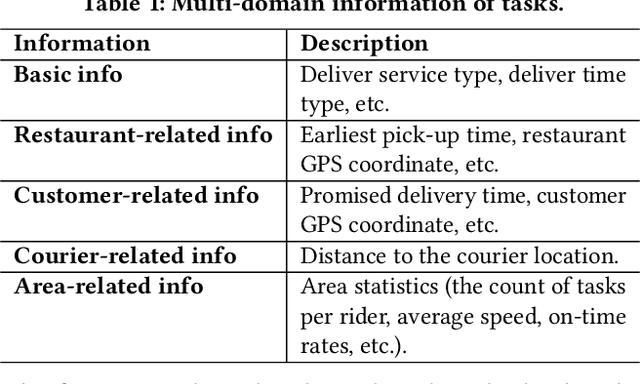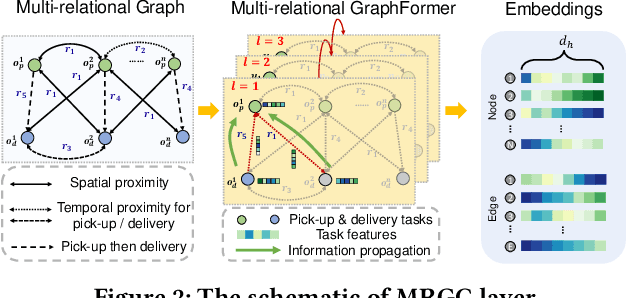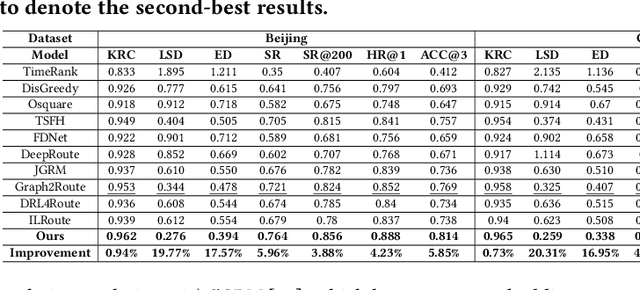Yuan Yuan
MIT CSAIL
MoveFM-R: Advancing Mobility Foundation Models via Language-driven Semantic Reasoning
Sep 26, 2025Abstract:Mobility Foundation Models (MFMs) have advanced the modeling of human movement patterns, yet they face a ceiling due to limitations in data scale and semantic understanding. While Large Language Models (LLMs) offer powerful semantic reasoning, they lack the innate understanding of spatio-temporal statistics required for generating physically plausible mobility trajectories. To address these gaps, we propose MoveFM-R, a novel framework that unlocks the full potential of mobility foundation models by leveraging language-driven semantic reasoning capabilities. It tackles two key challenges: the vocabulary mismatch between continuous geographic coordinates and discrete language tokens, and the representation gap between the latent vectors of MFMs and the semantic world of LLMs. MoveFM-R is built on three core innovations: a semantically enhanced location encoding to bridge the geography-language gap, a progressive curriculum to align the LLM's reasoning with mobility patterns, and an interactive self-reflection mechanism for conditional trajectory generation. Extensive experiments demonstrate that MoveFM-R significantly outperforms existing MFM-based and LLM-based baselines. It also shows robust generalization in zero-shot settings and excels at generating realistic trajectories from natural language instructions. By synthesizing the statistical power of MFMs with the deep semantic understanding of LLMs, MoveFM-R pioneers a new paradigm that enables a more comprehensive, interpretable, and powerful modeling of human mobility. The implementation of MoveFM-R is available online at https://anonymous.4open.science/r/MoveFM-R-CDE7/.
UniMove: A Unified Model for Multi-city Human Mobility Prediction
Aug 09, 2025Abstract:Human mobility prediction is vital for urban planning, transportation optimization, and personalized services. However, the inherent randomness, non-uniform time intervals, and complex patterns of human mobility, compounded by the heterogeneity introduced by varying city structures, infrastructure, and population densities, present significant challenges in modeling. Existing solutions often require training separate models for each city due to distinct spatial representations and geographic coverage. In this paper, we propose UniMove, a unified model for multi-city human mobility prediction, addressing two challenges: (1) constructing universal spatial representations for effective token sharing across cities, and (2) modeling heterogeneous mobility patterns from varying city characteristics. We propose a trajectory-location dual-tower architecture, with a location tower for universal spatial encoding and a trajectory tower for sequential mobility modeling. We also design MoE Transformer blocks to adaptively select experts to handle diverse movement patterns. Extensive experiments across multiple datasets from diverse cities demonstrate that UniMove truly embodies the essence of a unified model. By enabling joint training on multi-city data with mutual data enhancement, it significantly improves mobility prediction accuracy by over 10.2\%. UniMove represents a key advancement toward realizing a true foundational model with a unified architecture for human mobility. We release the implementation at https://github.com/tsinghua-fib-lab/UniMove/.
DistrAttention: An Efficient and Flexible Self-Attention Mechanism on Modern GPUs
Jul 23, 2025Abstract:The Transformer architecture has revolutionized deep learning, delivering the state-of-the-art performance in areas such as natural language processing, computer vision, and time series prediction. However, its core component, self-attention, has the quadratic time complexity relative to input sequence length, which hinders the scalability of Transformers. The exsiting approaches on optimizing self-attention either discard full-contextual information or lack of flexibility. In this work, we design DistrAttention, an effcient and flexible self-attention mechanism with the full context. DistrAttention achieves this by grouping data on the embedding dimensionality, usually referred to as $d$. We realize DistrAttention with a lightweight sampling and fusion method that exploits locality-sensitive hashing to group similar data. A block-wise grouping framework is further designed to limit the errors introduced by locality sensitive hashing. By optimizing the selection of block sizes, DistrAttention could be easily integrated with FlashAttention-2, gaining high-performance on modern GPUs. We evaluate DistrAttention with extensive experiments. The results show that our method is 37% faster than FlashAttention-2 on calculating self-attention. In ViT inference, DistrAttention is the fastest and the most accurate among approximate self-attention mechanisms. In Llama3-1B, DistrAttention still achieves the lowest inference time with only 1% accuray loss.
Enhancing Vector Quantization with Distributional Matching: A Theoretical and Empirical Study
Jun 18, 2025Abstract:The success of autoregressive models largely depends on the effectiveness of vector quantization, a technique that discretizes continuous features by mapping them to the nearest code vectors within a learnable codebook. Two critical issues in existing vector quantization methods are training instability and codebook collapse. Training instability arises from the gradient discrepancy introduced by the straight-through estimator, especially in the presence of significant quantization errors, while codebook collapse occurs when only a small subset of code vectors are utilized during training. A closer examination of these issues reveals that they are primarily driven by a mismatch between the distributions of the features and code vectors, leading to unrepresentative code vectors and significant data information loss during compression. To address this, we employ the Wasserstein distance to align these two distributions, achieving near 100\% codebook utilization and significantly reducing the quantization error. Both empirical and theoretical analyses validate the effectiveness of the proposed approach.
Breaking Data Silos: Towards Open and Scalable Mobility Foundation Models via Generative Continual Learning
Jun 07, 2025Abstract:Foundation models have revolutionized fields such as natural language processing and computer vision by enabling general-purpose learning across diverse tasks and datasets. However, building analogous models for human mobility remains challenging due to the privacy-sensitive nature of mobility data and the resulting data silos across institutions. To bridge this gap, we propose MoveGCL, a scalable and privacy-preserving framework for training mobility foundation models via generative continual learning. Without sharing raw data, MoveGCL enables decentralized and progressive model evolution by replaying synthetic trajectories generated from a frozen teacher model, and reinforces knowledge retention through a tailored distillation strategy that mitigates catastrophic forgetting. To address the heterogeneity of mobility patterns, MoveGCL incorporates a Mixture-of-Experts Transformer with a mobility-aware expert routing mechanism, and employs a layer-wise progressive adaptation strategy to stabilize continual updates. Experiments on six real-world urban datasets demonstrate that MoveGCL achieves performance comparable to joint training and significantly outperforms federated learning baselines, while offering strong privacy protection. MoveGCL marks a crucial step toward unlocking foundation models for mobility, offering a practical blueprint for open, scalable, and privacy-preserving model development in the era of foundation models.
TrajMoE: Spatially-Aware Mixture of Experts for Unified Human Mobility Modeling
May 24, 2025Abstract:Modeling human mobility across diverse cities is essential for applications such as urban planning, transportation optimization, and personalized services. However, generalization remains challenging due to heterogeneous spatial representations and mobility patterns across cities. Existing methods typically rely on numerical coordinates or require training city-specific models, limiting their scalability and transferability. We propose TrajMoE, a unified and scalable model for cross-city human mobility modeling. TrajMoE addresses two key challenges: (1) inconsistent spatial semantics across cities, and (2) diverse urban mobility patterns. To tackle these, we begin by designing a spatial semantic encoder that learns transferable location representations from POI-based functional semantics and visit patterns. Furthermore, we design a Spatially-Aware Mixture-of-Experts (SAMoE) Transformer that injects structured priors into experts specialized in distinct mobility semantics, along with a shared expert to capture city-invariant patterns and enable adaptive cross-city generalization. Extensive experiments demonstrate that TrajMoE achieves up to 27% relative improvement over competitive mobility foundation models after only one epoch of fine-tuning, and consistently outperforms full-data baselines using merely 5% of target city data. These results establish TrajMoE as a significant step toward realizing a truly generalizable, transferable, and pretrainable foundation model for human mobility.
TurnaboutLLM: A Deductive Reasoning Benchmark from Detective Games
May 21, 2025



Abstract:This paper introduces TurnaboutLLM, a novel framework and dataset for evaluating the deductive reasoning abilities of Large Language Models (LLMs) by leveraging the interactive gameplay of detective games Ace Attorney and Danganronpa. The framework tasks LLMs with identifying contradictions between testimonies and evidences within long narrative contexts, a challenging task due to the large answer space and diverse reasoning types presented by its questions. We evaluate twelve state-of-the-art LLMs on the dataset, hinting at limitations of popular strategies for enhancing deductive reasoning such as extensive thinking and Chain-of-Thought prompting. The results also suggest varying effects of context size, the number of reasoning step and answer space size on model performance. Overall, TurnaboutLLM presents a substantial challenge for LLMs' deductive reasoning abilities in complex, narrative-rich environments.
MRGRP: Empowering Courier Route Prediction in Food Delivery Service with Multi-Relational Graph
May 17, 2025



Abstract:Instant food delivery has become one of the most popular web services worldwide due to its convenience in daily life. A fundamental challenge is accurately predicting courier routes to optimize task dispatch and improve delivery efficiency. This enhances satisfaction for couriers and users and increases platform profitability. The current heuristic prediction method uses only limited human-selected task features and ignores couriers preferences, causing suboptimal results. Additionally, existing learning-based methods do not fully capture the diverse factors influencing courier decisions or the complex relationships among them. To address this, we propose a Multi-Relational Graph-based Route Prediction (MRGRP) method that models fine-grained correlations among tasks affecting courier decisions for accurate prediction. We encode spatial and temporal proximity, along with pickup-delivery relationships, into a multi-relational graph and design a GraphFormer architecture to capture these complex connections. We also introduce a route decoder that leverages courier information and dynamic distance and time contexts for prediction, using existing route solutions as references to improve outcomes. Experiments show our model achieves state-of-the-art route prediction on offline data from cities of various sizes. Deployed on the Meituan Turing platform, it surpasses the current heuristic algorithm, reaching a high route prediction accuracy of 0.819, essential for courier and user satisfaction in instant food delivery.
TAMO:Fine-Grained Root Cause Analysis via Tool-Assisted LLM Agent with Multi-Modality Observation Data
Apr 30, 2025Abstract:With the development of distributed systems, microservices and cloud native technologies have become central to modern enterprise software development. Despite bringing significant advantages, these technologies also increase system complexity and operational challenges. Traditional root cause analysis (RCA) struggles to achieve automated fault response, heavily relying on manual intervention. In recent years, large language models (LLMs) have made breakthroughs in contextual inference and domain knowledge integration, providing new solutions for Artificial Intelligence for Operations (AIOps). However, Existing LLM-based approaches face three key challenges: text input constraints, dynamic service dependency hallucinations, and context window limitations. To address these issues, we propose a tool-assisted LLM agent with multi-modality observation data, namely TAMO, for fine-grained RCA. It unifies multi-modal observational data into time-aligned representations to extract consistent features and employs specialized root cause localization and fault classification tools for perceiving the contextual environment. This approach overcomes the limitations of LLM in handling real-time changing service dependencies and raw observational data and guides LLM to generate repair strategies aligned with system contexts by structuring key information into a prompt. Experimental results show that TAMO performs well in root cause analysis when dealing with public datasets characterized by heterogeneity and common fault types, demonstrating its effectiveness.
Know Me, Respond to Me: Benchmarking LLMs for Dynamic User Profiling and Personalized Responses at Scale
Apr 19, 2025Abstract:Large Language Models (LLMs) have emerged as personalized assistants for users across a wide range of tasks -- from offering writing support to delivering tailored recommendations or consultations. Over time, the interaction history between a user and an LLM can provide extensive information about an individual's traits and preferences. However, open questions remain on how well LLMs today can effectively leverage such history to (1) internalize the user's inherent traits and preferences, (2) track how the user profiling and preferences evolve over time, and (3) generate personalized responses accordingly in new scenarios. In this work, we introduce the PERSONAMEM benchmark. PERSONAMEM features curated user profiles with over 180 simulated user-LLM interaction histories, each containing up to 60 sessions of multi-turn conversations across 15 real-world tasks that require personalization. Given an in-situ user query, i.e. query issued by the user from the first-person perspective, we evaluate LLM chatbots' ability to identify the most suitable response according to the current state of the user's profile. We observe that current LLMs still struggle to recognize the dynamic evolution in users' profiles over time through direct prompting approaches. As a consequence, LLMs often fail to deliver responses that align with users' current situations and preferences, with frontier models such as GPT-4.1, o4-mini, GPT-4.5, o1, or Gemini-2.0 achieving only around 50% overall accuracy, suggesting room for improvement. We hope that PERSONAMEM, along with the user profile and conversation simulation pipeline, can facilitate future research in the development of truly user-aware chatbots. Code and data are available at github.com/bowen-upenn/PersonaMem.
 Add to Chrome
Add to Chrome Add to Firefox
Add to Firefox Add to Edge
Add to Edge